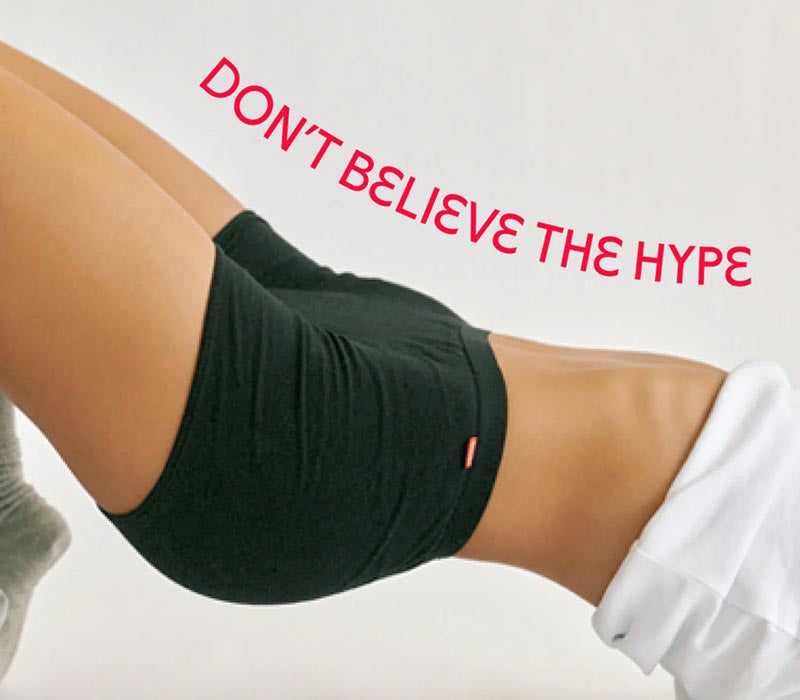We get it - you’ve probably been using tampons and pads since your very first period, so switching to period underwear is going to take a little getting used to. But trust us, once you understand what they are, how they work, and how safe they are, you’ll never look back!
Common Questions
How do they work?
Our period undies feel like, well, normal undies. The difference is they include a mix of leak-proof layers, moisture-wicking fabrics, and anti-bacterial elements that give up to 8 hours of leak-free protection (they’re also so comfy you’ll forget you’re even having a bleed - until the cravings kick back in).
Can I wear them all day?
Yes! We generally recommend changing them after eight hours, but it really depends on how light or heavy your flow is and the absorbency level of the period undies you’re wearing that day. Run, jump, swim, sweat, and play, your period won’t get in your way.
Is there any risk of Toxic Shock Syndrome (TSS)?
Not at all. TSS is caused by leaving tampons in too long, so if you wash your period pants after each use, there's no increased risk.
Mighty Myth: They’re only for women with light flows
Not at all! You can find period panties suited for any kind of flow (light, moderate, heavy, or for those just-in-case days). We have a fit for every flow. As a general guide:
- Super Light: It holds up to 1 teaspoon, equal to less than 1 regular tampon or 1 liner. It’s the perfect everyday underwear for light leaks and discharge, even when not on your period.
- Light: It holds up to 3 teaspoons, equal to 2 regular tampons or 1 pad, perfect for preventing pesky drips, discharge, and lighter flows.
- Moderate: It holds up to 5 teaspoons, equivalent to 3 regular tampons or 2 pads. Wear it on moderate dates or as an extra defense on heavy days with our Period Cup.
- Heavy: They hold up to 7 teaspoons, equivalent to 4 regular tampons or 3 pads, making them suitable for wear alone, day or night.
MYTH: You can only wear during your period
Not true! Even on days when you don't have your period (otherwise known as overflow days), they'll keep everything in place!
MYTH: They give off a funny smell
I believe that's your designer imposter perfume. JKS. They contain an odour-eliminating layer, so as long as washing guidelines are followed (see here), they won’t retain odour.
MYTH: They’ll feel wet
Our period underwear is designed with breathable fabrics to ensure moisture won't feel wet. They also won’t let anything seep through… because we’re big fans of white pants.
MYTH: They’re a hassle to wash
Not.At.All. You just machine wash like normal undies! Please don’t use fabric softeners or bleach, though – we want each genius layer to retain its integrity. You can also try our Laundry Bag to safeguard them on laundry day. Then just hang out to dry (the sunnier the better) or tumble dry on low - that’s it!
Big Benefits
Environmental Win
Not only are our reusable products leak-free, waste-free, and worry-free, but they also help you take care of the planet every single month. Think about it: Right now, bleeders use 400+ disposable products, collectively equal to 200,000 tonnes of landfill each year in Australia, with the plastic in disposables taking approximately 500 years to decompose. Imagine the impact a simple switch can have. Big wins.
Financial Gains
The upfront cost of reusable period underwear may be higher, but the long-term financial benefits are significant, as period underwear can last 2 years or more, and period cups can last 5 years or more. The average woman spends approximately $180 per year on single-use period items. Our Period Cup retails at $35. A three-pack of our Bikini Briefs is $89.95. We did the math, and it hurts our brains.
Down there Care
We care about what you put near your vagina. It's why our products are mighty comfy and safe for your bits. Trust us, we checked. Our products are cruelty-free, 100% vegan, sustainable, and free from chemical treatments (like PFAS).




